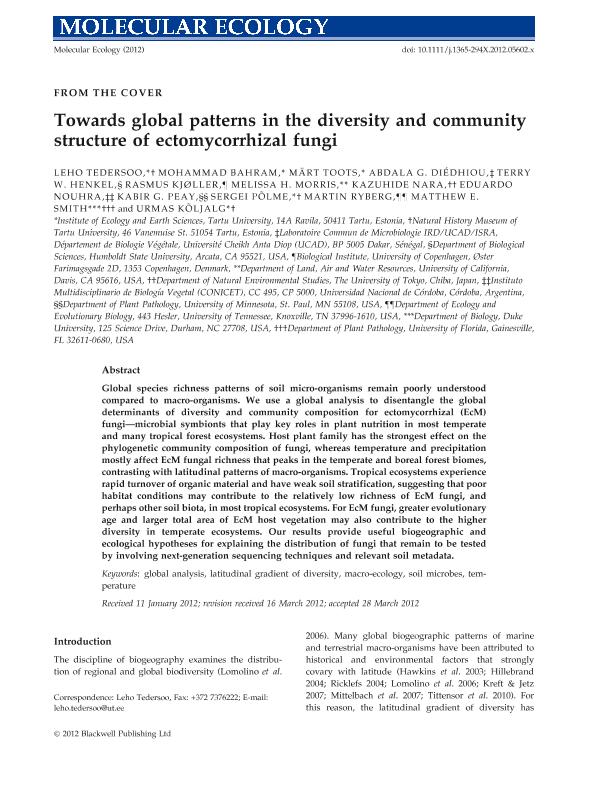Mostrar el registro sencillo del ítem
dc.contributor.author
Tedersoo, Leho
dc.contributor.author
Bahram, Mohammad
dc.contributor.author
Toots, Märt
dc.contributor.author
Diédhiou, Abdala G.
dc.contributor.author
Henkel, Terry W.
dc.contributor.author
Kjøller, Rasmus
dc.contributor.author
Morris, Melissa H.
dc.contributor.author
Nara, Kazuhide
dc.contributor.author
Nouhra, Eduardo Ramon

dc.contributor.author
Peay, Kabir
dc.contributor.author
Polme, Sergei
dc.contributor.author
Ryberg, Martin
dc.contributor.author
Smith, Matthew
dc.contributor.author
Koljalg, Urmas
dc.date.available
2017-06-14T18:48:53Z
dc.date.issued
2012-09
dc.identifier.citation
Tedersoo, Leho; Bahram, Mohammad; Toots, Märt; Diédhiou, Abdala G.; Henkel, Terry W.; et al.; Towards global patterns in the diversity and community structure of ectomycorrhizal fungi; Wiley Blackwell Publishing, Inc; Molecular Ecology; 21; 17; 9-2012; 4160-4170
dc.identifier.issn
0962-1083
dc.identifier.uri
http://hdl.handle.net/11336/18182
dc.description.abstract
Global species richness patterns of soil micro-organisms remain poorly understood compared to macro-organisms. We use a global analysis to disentangle the global determinants of diversity and community composition for ectomycorrhizal (EcM) fungi—microbial symbionts that play key roles in plant nutrition in most temperate and many tropical forest ecosystems. Host plant family has the strongest effect on the phylogenetic community composition of fungi, whereas temperature and precipitation mostly affect EcM fungal richness that peaks in the temperate and boreal forest biomes, contrasting with latitudinal patterns of macro-organisms. Tropical ecosystems experience rapid turnover of organic material and have weak soil stratification, suggesting that poor habitat conditions may contribute to the relatively low richness of EcM fungi, and perhaps other soil biota, in most tropical ecosystems. For EcM fungi, greater evolutionary age and larger total area of EcM host vegetation may also contribute to the higher diversity in temperate ecosystems. Our results provide useful biogeographic and ecological hypotheses for explaining the distribution of fungi that remain to be tested by involving next-generation sequencing techniques and relevant soil metadata.
dc.format
application/pdf
dc.language.iso
eng
dc.publisher
Wiley Blackwell Publishing, Inc

dc.rights
info:eu-repo/semantics/openAccess
dc.rights.uri
https://creativecommons.org/licenses/by-nc-sa/2.5/ar/
dc.subject
Global Analysis
dc.subject
Latitudinal Gradient of Diversity
dc.subject
Macro Ecology
dc.subject
Soil Microbes
dc.subject.classification
Micología

dc.subject.classification
Ciencias Biológicas

dc.subject.classification
CIENCIAS NATURALES Y EXACTAS

dc.title
Towards global patterns in the diversity and community structure of ectomycorrhizal fungi
dc.type
info:eu-repo/semantics/article
dc.type
info:ar-repo/semantics/artículo
dc.type
info:eu-repo/semantics/publishedVersion
dc.date.updated
2017-05-31T15:36:55Z
dc.identifier.eissn
0962-1083
dc.journal.volume
21
dc.journal.number
17
dc.journal.pagination
4160-4170
dc.journal.pais
Reino Unido

dc.journal.ciudad
Londres
dc.description.fil
Fil: Tedersoo, Leho. Tartu University. Institute of Ecology and Earth Sciences; Estonia. Natural History Museum of
Tartu University; Estonia
dc.description.fil
Fil: Bahram, Mohammad. Tartu University. Institute of Ecology and Earth Sciences; Estonia
dc.description.fil
Fil: Toots, Märt. Tartu University. Institute of Ecology and Earth Sciences; Estados Unidos
dc.description.fil
Fil: Diédhiou, Abdala G.. Université Cheikh Anta Diop. Département de Biologie Végétale. Laboratoire Commun de Microbiologie; Senegal
dc.description.fil
Fil: Henkel, Terry W.. Humboldt State University. Department of Biological Sciences; Estados Unidos
dc.description.fil
Fil: Kjøller, Rasmus. University of Copenhagen. Biological Institute; Dinamarca
dc.description.fil
Fil: Morris, Melissa H.. University of California. Department of Land, Air and Water Resources; Estados Unidos
dc.description.fil
Fil: Nara, Kazuhide. The University of Tokyo. Department of Natural Environmental Studies; Japón
dc.description.fil
Fil: Nouhra, Eduardo Ramon. Consejo Nacional de Investigaciones Científicas y Técnicas. Centro Científico Tecnológico Conicet - Córdoba. Instituto Multidisciplinario de Biología Vegetal. Universidad Nacional de Córdoba. Facultad de Ciencias Exactas Físicas y Naturales. Instituto Multidisciplinario de Biología Vegetal; Argentina
dc.description.fil
Fil: Peay, Kabir. University of Minnesota. Department of Plant Pathology; Estados Unidos
dc.description.fil
Fil: Polme, Sergei. Tartu University. Institute of Ecology and Earth Sciences; Estonia. Natural History Museum of Tartu University; Estonia
dc.description.fil
Fil: Ryberg, Martin. University of Tennessee. Department of Ecology and Evolutionary Biology; Estados Unidos
dc.description.fil
Fil: Smith, Matthew. Duke University. Department of Biology; Reino Unido. University of Florida. Department of Plant Pathology; Estados Unidos
dc.description.fil
Fil: Koljalg, Urmas. Tartu University. Institute of Ecology and Earth Sciences; Estonia. Natural History Museum of Tartu University; Estonia
dc.journal.title
Molecular Ecology

dc.relation.alternativeid
info:eu-repo/semantics/altIdentifier/url/http://onlinelibrary.wiley.com/doi/10.1111/j.1365-294X.2012.05602.x/full
dc.relation.alternativeid
info:eu-repo/semantics/altIdentifier/doi/http://dx.doi.org/10.1111/j.1365-294X.2012.05602.x
Archivos asociados
